Downregulation of Cavin-1 Expression via Increasing Caveolin-1 Degradation Prompts the Proliferation and Migration of Vascular Smooth Muscle Cells in Balloon Injury-Induced Neointimal Hyperplasia
- PMID: 28751541
- PMCID: PMC5586430
- DOI: 10.1161/JAHA.117.005754
Downregulation of Cavin-1 Expression via Increasing Caveolin-1 Degradation Prompts the Proliferation and Migration of Vascular Smooth Muscle Cells in Balloon Injury-Induced Neointimal Hyperplasia
Abstract
Background: Percutaneous coronary intervention has been widely used in the treatment of ischemic heart disease, but vascular restenosis is a main limitation of percutaneous coronary intervention. Our previous work reported that caveolin-1 had a key functional role in intimal hyperplasia, whereas whether Cavin-1 (another important caveolae-related protein) was involved is still unknown. Therefore, we will investigate the effect of Cavin-1 on neointimal formation.
Methods and results: Balloon injury markedly reduced Cavin-1 protein and enhanced ubiquitin protein expression accompanied with neointimal hyperplasia in injured carotid arteries, whereas Cavin-1 mRNA had no change. In cultured vascular smooth muscle cells (VSMCs), Cavin-1 was downregulated after inhibition of protein synthesis by cycloheximide, which was distinctly prevented by pretreatment with proteasome inhibitor MG132 but not by lysosomal inhibitor chloroquine, suggesting that proteasomal degradation resulted in Cavin-1 downregulation. Knockdown of Cavin-1 by local injection of Cavin-1 short hairpin RNA (shRNA) into balloon-injured carotid arteries in vivo promoted neointimal formation. In addition, inhibition or overexpression of Cavin-1 in cultured VSMCs in vitro prompted or suppressed VSMC proliferation and migration via increasing or decreasing extracellular signal-regulated kinase phosphorylation and matrix-degrading metalloproteinases-9 activity, respectively. However, under basic conditions, the effect of Cavin-1 on VSMC migration was stronger than on proliferation. Moreover, our results indicated that Cavin-1 regulated caveolin-1 expression via lysosomal degradation pathway.
Conclusions: Our study revealed the role and the mechanisms of Cavin-1 downregulation in neointimal formation by promoting VSMC proliferation, migration, and synchronously enhancing caveolin-1 lysosomal degradation. Cavin-1 may be a potential therapeutic target for the treatment of postinjury vascular remodeling.
Keywords: Cavin‐1; caveolin‐1; migration; neointimal hyperplasia; polymerase I and transcript release factor; proliferation; vascular smooth muscle.
© 2017 The Authors. Published on behalf of the American Heart Association, Inc., by Wiley.
Figures

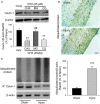
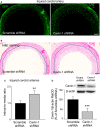
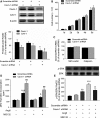
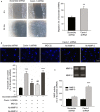

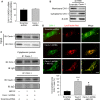
Similar articles
-
Reversion-inducing-cysteine-rich protein with Kazal motif is involved in intimal hyperplasia in carotid arteries: a new insight in the prevention of restenosis after vascular angioplasty.Ann Vasc Surg. 2015 Aug;29(6):1293-9. doi: 10.1016/j.avsg.2015.01.032. Epub 2015 May 22. Ann Vasc Surg. 2015. PMID: 26004948
-
An essential role for stromal interaction molecule 1 in neointima formation following arterial injury.Cardiovasc Res. 2009 Mar 1;81(4):660-8. doi: 10.1093/cvr/cvn338. Epub 2008 Dec 3. Cardiovasc Res. 2009. PMID: 19052075
-
Novel roles of Nrf3-Trim5 axis in vascular smooth muscle cell dysfunctions and neointimal hyperplasia.Cardiovasc Res. 2025 Jul 31;121(8):1282-1298. doi: 10.1093/cvr/cvaf084. Cardiovasc Res. 2025. PMID: 40377016 Free PMC article.
-
Role of smooth muscle cells in coronary artery bypass grafting failure.Cardiovasc Res. 2018 Mar 15;114(4):601-610. doi: 10.1093/cvr/cvy021. Cardiovasc Res. 2018. PMID: 29373656 Free PMC article. Review.
-
Smooth muscle cell signal transduction: implications of vascular biology for vascular surgeons.J Vasc Surg. 2007 Jun;45 Suppl A(6S):A15-24. doi: 10.1016/j.jvs.2007.02.061. J Vasc Surg. 2007. PMID: 17544020 Free PMC article. Review.
Cited by
-
Caveolae and Lipid Rafts in Endothelium: Valuable Organelles for Multiple Functions.Biomolecules. 2020 Aug 21;10(9):1218. doi: 10.3390/biom10091218. Biomolecules. 2020. PMID: 32825713 Free PMC article. Review.
-
Critical Role of Caveolin-1 Loss/Dysfunction in Pulmonary Hypertension.Med Sci (Basel). 2021 Sep 22;9(4):58. doi: 10.3390/medsci9040058. Med Sci (Basel). 2021. PMID: 34698188 Free PMC article. Review.
-
Ion Channel Regulation in Caveolae and Its Pathological Implications.Cells. 2025 Apr 24;14(9):631. doi: 10.3390/cells14090631. Cells. 2025. PMID: 40358155 Free PMC article. Review.
-
Caveolin as a Novel Potential Therapeutic Target in Cardiac and Vascular Diseases: A Mini Review.Aging Dis. 2020 Mar 9;11(2):378-389. doi: 10.14336/AD.2019.09603. eCollection 2020 Apr. Aging Dis. 2020. PMID: 32257548 Free PMC article. Review.
-
Total Flavonoids of Polygala fallax Hemsl Induce Apoptosis of Human Ectopic Endometrial Stromal Cells through PI3K/AKT/Bcl-2 Signaling Pathway.Gynecol Obstet Invest. 2023;88(4):197-213. doi: 10.1159/000530104. Epub 2023 Mar 17. Gynecol Obstet Invest. 2023. PMID: 36934719 Free PMC article.
References
-
- Nagaraja V, Ooi SY, Nolan J, Large A, De BM, Ludman P, Bagur R, Curzen N, Matsukage T, Yoshimachi F, Kwok CS, Berry C, Mamas MA. Impact of incomplete percutaneous revascularization in patients with multivessel coronary artery disease: a systematic review and meta‐analysis. J Am Heart Assoc. 2016;5:e004598 DOI: 10.1161/JAHA.116.004598 - DOI - PMC - PubMed
-
- Alfonso F, Byrne RA, Rivero F, Kastrati A. Current treatment of in‐stent restenosis. J Am Coll Cardiol. 2014;63:2659–2673. - PubMed
-
- Misumida N, Aoi S, Saeed M, Ota T, Eda T, Umeda H, Kanei Y. The role of angiographic follow‐up after percutaneous coronary intervention. Int J Cardiol. 2016;222:911–920. - PubMed
-
- Siontis GC, Stefanini GG, Mavridis D, Siontis KC, Alfonso F, Perez‐Vizcayno MJ, Byrne RA, Kastrati A, Meier B, Salanti G, Juni P, Windecker S. Percutaneous coronary interventional strategies for treatment of in‐stent restenosis: a network meta‐analysis. Lancet. 2015;386:655–664. - PubMed
MeSH terms
Substances
LinkOut - more resources
Full Text Sources
Other Literature Sources

